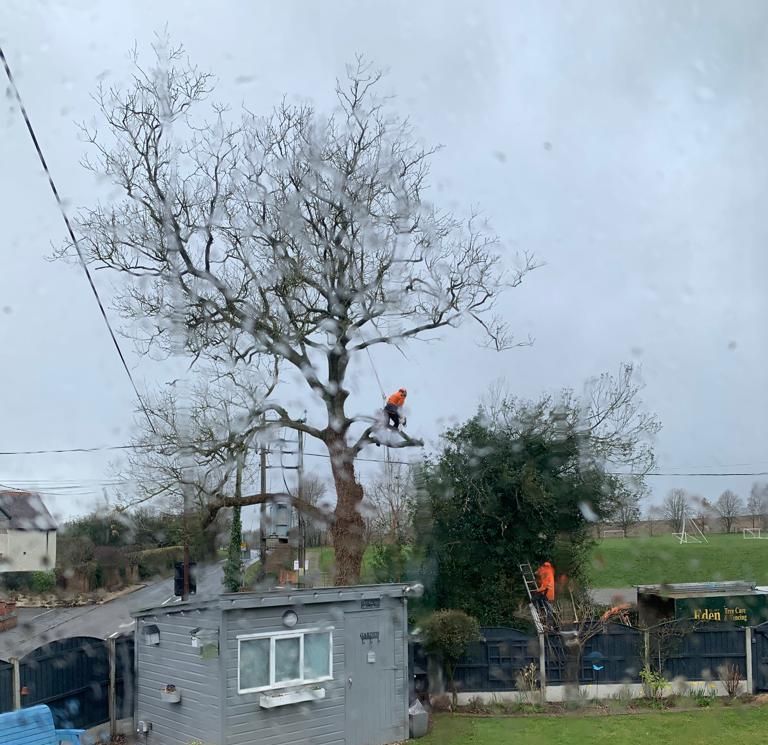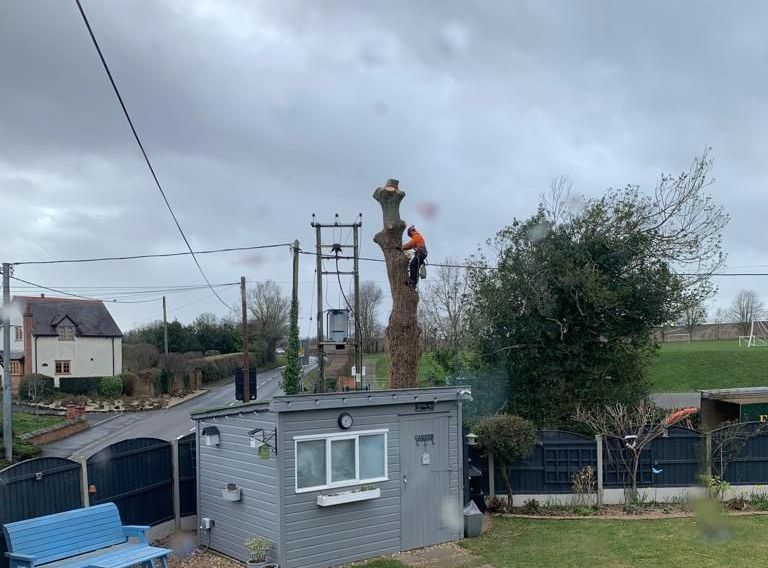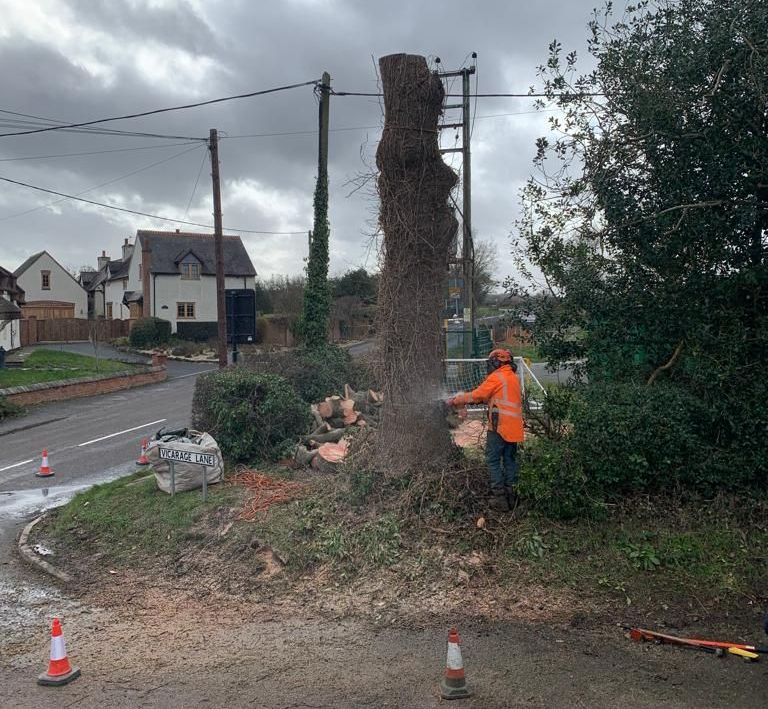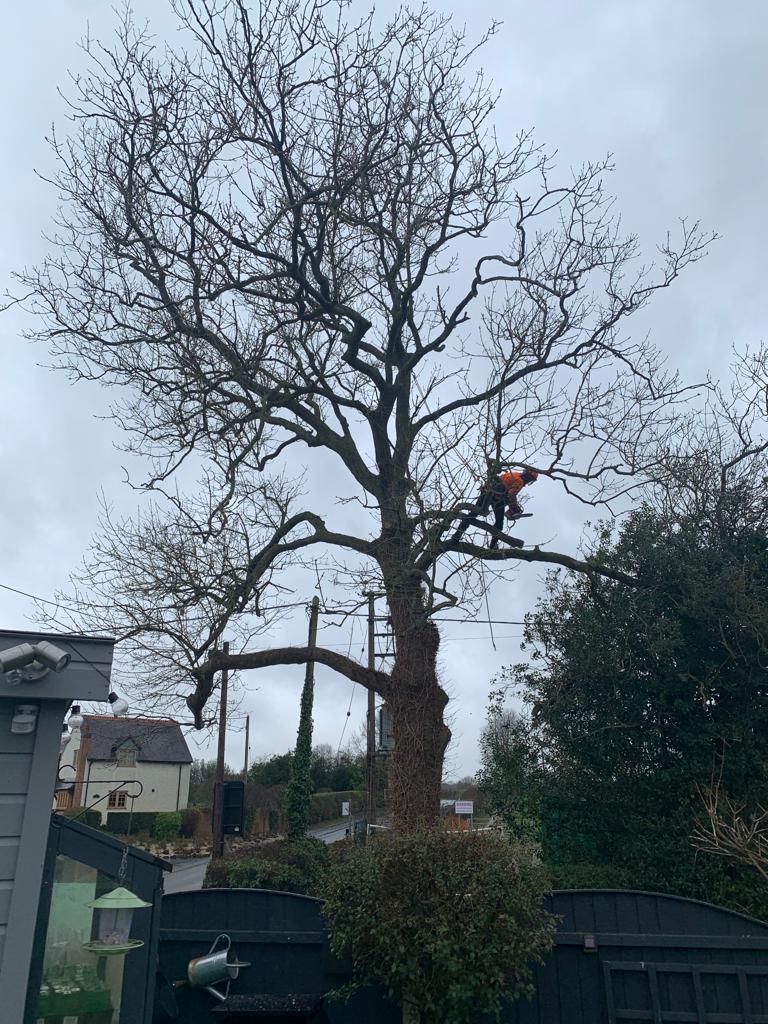How We Safely Dismantled A Diseased Tree With Ash Dieback
How We Safely Dismantled A Diseased Tree With Ash Dieback
Eden Tree Care were called to investigate a protected Ash tree by Packington Parish Council. The Council were concerned the tree could pose a threat of danger to the public.
The team responded quickly to the Council and attended the scene to conduct a thorough risk assessment. Following the assessment, the tree was sadly found to have Ash Dieback. The tree was located on one of the busier roads in Packington and due to the position of the tree to various hazards including a public car park, telephone and power lines; the best course of action was to dismantle the tree.
What is Ash Dieback?
Ash dieback is a highly infectious fungal disease that affects ash trees and could wipe out 90% of native ash trees. The gov.uk Forest Research site has released information and resources to help identify signs of Ash Dieback such as blackening and wilting of leaves and shoots from mid to late summer and crown dieback.
Forest Research are keen on keeping an eye on the spread of Ash Dieback so changes can be monitored in distribution.
Unfortunately, there is no known cure for Ash Dieback, therefore it is essential to keep an eye on infected trees. Diseased trees are at high risk of losing branches or even failing completely, putting public safety at risk. This risk can be compounded during the winter months when high winds and heavy rainfall add further stress to weakened trees.
What was the removal process of the Ash Dieback tree?
In this instance, the tree had infection levels of over 50% which meant felling was the only option. Since the tree in question sat within a Conservation Area boundary any works would need planning permission. Eden Tree Care submitted a planning permission application to NWLDC in order to gain approval for the works to go ahead. Once permission was granted work was able to commence on the infected tree.
Eden’s skilled arborist team assessed the tree's location to fully understand how to tackle removing the tree without causing damage or disruption to the local area.
From assessment, a busy road, public car park, power lines and telephone wires all added to the delicacy of this job in Packington. The photo below shows just how many hazards were surrounding the tree.

The lead climber opted for a sectional dismantle rather than felling the tree in one cut, this ensured the safe removal of the Ash Tree and dramatically reduced any risk to the public or property. The process begins with the climbing arborist dismantling the canopy and then lowering using a rope and pulley system to the waiting ground staff - Eden pride themselves on having a high skill set and this job was a great chance to display their expertise and experience.

Once the outer limbs were removed, Eden’s Arborist made a start on dismantling the main trunk into small sections until the height was low enough to fell what remained of the tree. Despite the rain (the team are used to working in all weather!), the most technical part of the job was now complete and the Head Arborist can return to ground level to complete the final stage of the job.

With the trunk at a manageable height, the team could safely fell the tree from the ground and log it into manageable chunks. Finally, the team tidied up the area ensuring all timber and brash were either chipped or kept for firewood. The logs were left on site for local residents to use as firewood. It is a sad day for the Ash tree, Eden reflected - the only small consolation is that the Ash tree chippings will be sold on for biomass, creating green energy for the biofuel industry.
How We Safely Dismantled A Diseased Tree With Ash Dieback
Eden Tree Care were called to investigate a protected Ash tree by Packington Parish Council. The Council were concerned the tree could pose a threat of danger to the public.
The team responded quickly to the Council and attended the scene to conduct a thorough risk assessment. Following the assessment, the tree was sadly found to have Ash Dieback. The tree was located on one of the busier roads in Packington and due to the position of the tree to various hazards including a public car park, telephone and power lines; the best course of action was to dismantle the tree.
What is Ash Dieback?
Ash dieback is a highly infectious fungal disease that affects ash trees and could wipe out 90% of native ash trees. The gov.uk Forest Research site has released information and resources to help identify signs of Ash Dieback such as blackening and wilting of leaves and shoots from mid to late summer and crown dieback.
Forest Research are keen on keeping an eye on the spread of Ash Dieback so changes can be monitored in distribution.
Unfortunately, there is no known cure for Ash Dieback, therefore it is essential to keep an eye on infected trees. Diseased trees are at high risk of losing branches or even failing completely, putting public safety at risk. This risk can be compounded during the winter months when high winds and heavy rainfall add further stress to weakened trees.
What was the removal process of the Ash Dieback tree?
In this instance, the tree had infection levels of over 50% which meant felling was the only option. Since the tree in question sat within a Conservation Area boundary any works would need planning permission. Eden Tree Care submitted a planning permission application to NWLDC in order to gain approval for the works to go ahead. Once permission was granted work was able to commence on the infected tree.
Eden’s skilled arborist team assessed the tree's location to fully understand how to tackle removing the tree without causing damage or disruption to the local area.
From assessment, a busy road, public car park, power lines and telephone wires all added to the delicacy of this job in Packington. The photo below shows just how many hazards were surrounding the tree.

The lead climber opted for a sectional dismantle rather than felling the tree in one cut, this ensured the safe removal of the Ash Tree and dramatically reduced any risk to the public or property. The process begins with the climbing arborist dismantling the canopy and then lowering using a rope and pulley system to the waiting ground staff - Eden pride themselves on having a high skill set and this job was a great chance to display their expertise and experience.

Once the outer limbs were removed, Eden’s Arborist made a start on dismantling the main trunk into small sections until the height was low enough to fell what remained of the tree. Despite the rain (the team are used to working in all weather!), the most technical part of the job was now complete and the Head Arborist can return to ground level to complete the final stage of the job.

With the trunk at a manageable height, the team could safely fell the tree from the ground and log it into manageable chunks. Finally, the team tidied up the area ensuring all timber and brash were either chipped or kept for firewood. The logs were left on site for local residents to use as firewood. It is a sad day for the Ash tree, Eden reflected - the only small consolation is that the Ash tree chippings will be sold on for biomass, creating green energy for the biofuel industry.


